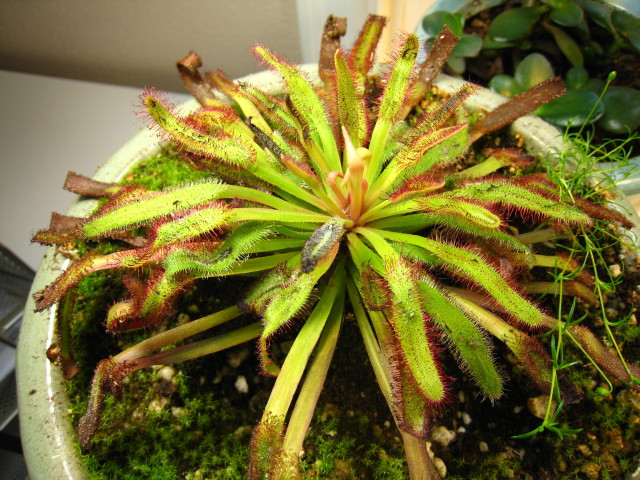Question
 Declining Cape Sundew
Declining Cape Sundew
I have a mature cape sundew that formerly was doing quite well but now appears to be in decline. I have owned this plant for seven or eight years. It had grown quite large, as you can see from the included photo, with huge paddle-shaped leaves. It has produced some additional plants (that are healthy) via root cuttings. I had been growing it under fluorescent lights, with some ambient light also coming from a nearby south-facing window. At some point, I noticed that the newer leaves were becoming progressively smaller; eventually, they degenerated to the point where the newest leaves sprouted rather twisted and deformed. I had not repotted this plant in probably about two years, and the soil did smell a bit foul, so I repotted into a larger and deeper pot, and treated with fungicide and systemic insecticide. I also moved the plant closer to the window to get more natural light (and it still is under a fluorescent bulb). It did seem to make some steps in the right direction: the misshapen leaves opened and produced dew, and then a newer batch of leaves seemed to develop normally. However, the plant still lacks its earlier vigor and it seems to me that it is still in decline. Any advice you could provide would be appreciated.
AnswerHi Robert,
Thank-you for sending a photo. That always helps.
Over the years I've seen Cape Sundews behave like this, and I'm not totally sure what causes it. The broadleaf form seems particularly prone to this behavior. My personal theory is that D. capensis has more of a creeping habit in nature, and that being potted doesn't allow them to spread across the ground they way they like to. So, they grow well to a point, then start slowing down. You'll often see the big side roots being produced on the sides of them stem like they are wanting to attach to new ground the way they might on a hillside.
What you can do is repot into some fresh soil, trim off most of the leaves except the crown and maybe one row of leaves closest to the top. When you repot, be sure to place the plant deep into the soil so the new side-roots are covered. It was a good idea to treat for bugs since that can cause this appearance too.
Another option is to cut the top of the plant off below one of the side roots. Trim all of the leaves off if that except the crown, and pot it up. It will take off in a couple of weeks. The stump you left behind will usually send up multiple new shoots in a few weeks. Repotting into fresh soil is still a good idea with the decapitated section. Continue to keep them in bright light and wet.
Good Growing!
Jeff Dallas
Sarracenia Northwest
http://www.cobraplant.com






